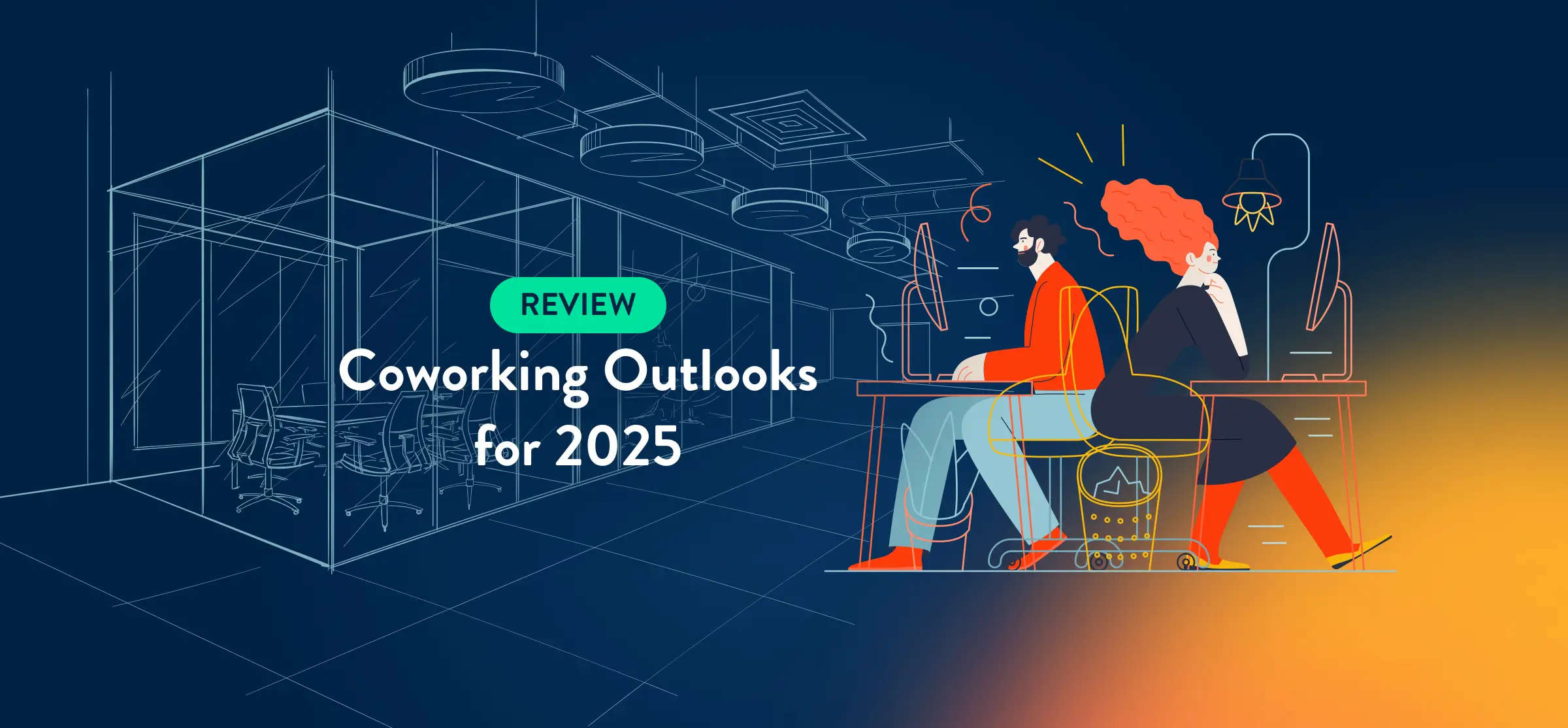
The coworking market continues to evolve and, with Q3 now underway, it’s the perfect time to revisit the predictions made at the start of this year. Our “Coworking Trends in 2025” webinar, moderated by Florian Kappes, Director, Europe, invited industry leaders to share their predictions for the year ahead. We heard from Annette Sturm, Head of Key Accounts at Design Offices, Jekaterina Kosmaceva, Regional SVP at IWG, Pauline Roussel, CEO at Coworkies, and Tom Redmayne, SVP, Head of Europe & Global Sales at Industrious.
How are their forecasts holding up six months on? This article looks at the mid-year coworking trends for 2025 and shares some key insights from the webinar discussion.
Trend 1: Uptake in management agreements
One of the most talked-about 2025 predictions centres on the uptake of management agreements, a revenue-sharing model between operators and landlords. “The fixed lease model for flex isn’t dead, but it’s only on rare occasions that it makes sense,” says Tom Redmayne, explaining that, however profitable a business might be, signing a 15-20 year traditional lease places huge financial risk, especially if another black swan event, like the pandemic, were to recur. Over the next five years, he predicts that management agreements will become adopted more widely.
A recent workthere report released by Savills supports this prediction. At the end of Q1 2025, management agreements made up 67% of flexible workspace leases in the UK, the highest proportion ever. “London is always setting the trend, and the rest follows,” Pauline Roussel explains, about the growing interest in management agreements across Europe.
Germany has been slower to adopt management agreements, but in January, Industrious announced expansion plans to Germany under management agreements, while Dutch flex space operator InfinitSpace has been at the forefront of adopting management agreements in Germany since 2022.
Periods of weaker economic and geopolitical uncertainty typically drive the uptake of management agreements. Macroeconomic factors, such as inflation, market instability, cost of services, and political movements, were predicted to impact the flexible workspace market in 2025, leading to more management agreements being signed.
Trend 2: Entry into new markets
Although the uptake of management agreements enables more coworking players to enter the industry, Tom Redmayne warns that the oversaturation of the coworking market may create challenges. He infers, ‘competition is growing, desk rates aren’t.’
Jekaterina Kosmaceva observes that “the biggest challenge is finding the niche to be successful in, the biggest opportunity is to grow within that niche.” In 2025, the influence of entering niche industries and regional markets was not to be underestimated. IWG has previously opened in smaller locations, such as Serbia and Lithuania, and in secondary cities. Similarly, Design Offices have opened in locations with growing demand, such as Munich (the country’s second largest market after Berlin).
In June, IWG announced a strategic 10-year partnership with SmartLabs, a flexible, customised lab space provider. Flexible, fully-equipped coworking labs are becoming one of the fastest-growing trends in the science and innovation property sector, with market leaders, such as Kadans, leading growth in the sector and opening locations across London and regional UK towns.
Trend 3: Flex and fit-out
Coworking labs are gaining popularity due to the convenience of turnkey, fully equipped workspaces enabling immediate occupancy. Likewise, occupier expectations in the flex space market have evolved from traditional CAT A workspaces to CAT A+ and CAT B.
IWG is listening closely to its customers, enabling on-demand furniture services and the ability to customise workspaces to meet evolving needs. In fact, 25-35% of its revenue comes from services, such as on-demand furniture and IT requirements, shares Jekaterina Kosmaceva. Likewise, at Design Offices, ‘flexibility is very important. If our tenants want to grow or downsize, we’re open to talk about that,’ explains Annette Sturm, who has seen more requests for customisable workspaces.
Cushman and Wakefield’s Q1 2025 report found that a substantial 55% of available commercial spaces marketed in Central London come fitted out. This shift is predicted to continue as occupiers face rising rents, increasing service charges, higher business rates, and exponential fit-out costs. But who fronts the investment? Tom Redmayne explains that customers expect landlords to cover the cost, as the asset ultimately belongs to them. The growing demand for landlord-delivered CAT A+ was explored in further detail in our latest Breaking into Flex report.
Trend 4: An “ecosystem of services”
Leasing flexible workspace is no longer seen as ‘a back office flexible solution…but a core part of their real estate strategy forward,’ says Tom Redmayne, about one of the biggest mega trends impacting the flex space industry this year. But what landlords and operators must get right is the workplace experience. Industrious and IWG are currently laser-focussed on tenant satisfaction and NPS (Net Promoter Score).
“Coworking spaces are becoming ecosystems of services,” explains Pauline Roussel. The basic layer is a place to work, with amenities and services added on top, such as
podcast studios, which are “popping up everywhere.” In March, Allwork.Space claimed that the projected growth of the $4 billion podcast industry will increase further demand for podcast studios in flexible workspaces this year. Annette Sturm sees greater demand for separate, confidential spaces, while Pauline Roussel shares that phone booth rentals in Japan are on the rise.
But coworking spaces can’t exist in isolation. Tom Redmayne implies that providers and landlords are beginning “to think conceptually about the experience in the building as a whole.” For example, the Industrious tenant experience manager product is deployed to activate spaces, such as entrance lobbies, delivering “a better all-encompassing experience.” Similarly, Design Offices activates its entrances with a coffee machine and barista service.
Trend 5: AI will play a key role in the flexible workspace sector
Phone booths, meeting rooms, and more distinct amenities, including podcast studios, serve as a valuable revenue generator for coworking spaces. To enhance the customer experience even further, booking amenities must be a frictionless process, supported by technology and AI.
The panel has all embraced AI in some form. For instance, Design Offices uses AI for internal and external smaller room bookings and coworking desk bookings. While Industrious develops customer ICPs with AI, endeavouring to use technology to explore further possibilities as the future of workspace design is predicted to become much more sophisticated. According to Tom Redmayne, “AI is going to fundamentally disrupt how our customers work and their roles in the workplace.”
Technology is also expected to disrupt research and the way coworking spaces market themselves. Pauline Roussel urges operators to use open-source tools, such as ChatGPT, with caution so as not to dilute their brands. For Jekaterina Kosmaceva, “technology is massively handy.” IWG employs AI for sales, implementing a virtual assistant to deliver faster responses to enquiries.
Coworking Trends 2026
The coworking movement shows no signs of slowing down. We can’t wait to see what trends continue to develop over the remainder of this year and which trends will emerge for 2026.
Watch the webinar discussion to dive deeper into the panel’s predicted trends for this year.
Recent articles

Flex Expansion and How to Win in New Markets

Circular By Design: Rethinking the Workspace Lifecycle
